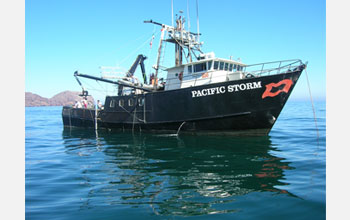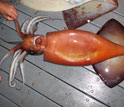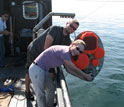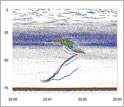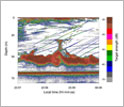|

Discovery
Scientists See Squid Attack Squid

Oregon State oceanographer Kelly Benoit-Bird and colleagues succeed in using sonar to track Humboldt squid
June 27, 2008
It was like a scene from a grade-B horror film. On a gently rocking vessel in the warm waters of the Sea of Cortez, a young oceanographer earnestly watches her computer screen while colleagues lower a cable into the water. Instruments aboard the ship, the Pacific Storm, ping sound waves toward the cable. The oceanographer's eyes flicker across the screen to make sure the signal is clear. Tethered to the cable is a 5-pound Humboldt squid, and the sound waves, set at 38 kilohertz, bounce off the squid. An image shows up on the screen. The oceanographer raises her fist in triumph. This marks the first time scientists had clearly picked up a strong sonar signal for squid, which lack the bones and swim bladders that give away other marine creatures. Suddenly a second image appears, darting up from below. The acoustic signal tracks it from the depths toward the cable--and the tethered squid. It is another squid, larger than the first, and it attacks the tethered animal. The oceanographer screams. Fade to black. "Actually, I think I swore instead of screamed," says Kelly Benoit-Bird cheerfully. "We were watching it in 'real time' and it was like a scene from a scary movie. But in this case, the science is real." In April, Benoit-Bird, an assistant professor in Oregon State University's College of Oceanic and Atmospheric Sciences, published a paper in the journal Acoustical Society of America on her success, and she received 19 e-mails from colleagues the first day the article appeared. "I've never had such a response before," she says. Co-authors included William Gilly of Stanford University's Hopkins Marine Station, Whitlow Au of the University of Hawaii and Bruce Mate of OSU's Marine Mammal Institute. Support for the work came from the Marine Mammal Endowment at OSU and from a National Science Foundation (NSF) grant to Gilly. The reasons for the excitement are two-fold. On one hand, the ability to track squid with sonar may reveal new details about how ocean ecosystems work. Squid are thought to be a primary food source for sperm whales, but ecologists have never been sure how the whales hunt. A study just five years ago concluded that whales couldn't use echolocation to target squid because signals wouldn't reflect off the squids' soft bodies. Now, researchers will need to re-examine the capacity of whales, dolphins, porpoises and other marine creatures to use their own sonar. Part of a NSF-supported study, Benoit-Bird's research is also important because it gives scientists a new way to look at an important link in the marine food chain. Squid may not have been properly appreciated, but their impact is becoming apparent. The Humboldt squid appears to be expanding its territory, moving from the Pacific Ocean off Mexico and California into the colder waters near Oregon. And that is causing some concern. "The Humboldt squid is a voracious predator that will eat anything it can get its tentacles on," Benoit-Bird says. "We put a pair of 10-pound squid into a tank and one immediately beheaded the other. These are fierce little beasts." Mexican fishermen have a name for the Humboldt squid: diablos rojos, or red devils. Known for their strength and razor-sharp beaks, these animals flash red and white at the end of a fishing line. They can get as large as six feet in length and weigh up to 100 pounds, though adults more typically weigh 20 to 40 pounds. They travel in schools of up to a thousand squid and will eat any fish in sight. In the Sea of Cortez, the Humboldt squid target lanternfish but are opportunistic feeders. They are highly energetic and require a lot of food to maintain their metabolic rate. Their move into northern California, Oregon and Washington--at a time when salmon stocks are depressed--is a concern to scientists like Benoit-Bird, who studies ecological interactions among marine species. "Typically, when a species moves into a new area, it adapts," she says. "If they can't find the lanternfish they ate in the Sea of Cortez, they may look at juvenile salmon, as well as herring, sardines and other species that salmon may eat. "Then there is the flip side of the equation," Benoit-Bird points out. "What will target the Humboldt squid as prey? In Mexico, it is the sperm whale, but they are uncommon off Oregon. Most of our whales are baleen whales, and these squid will be too big for them. Perhaps orcas, perhaps sharks--or they may have free rein." Next to sperm whales, the primary predators for the Humboldt squid in Mexico are coastal villagers who row their wooden boats offshore at night, when the red devils are closer to the surface. Fishermen catch squid by the hundreds and sell them for food. It doesn't appear that over-fishing is a problem. National Geographic recently reported that some 10 million squid might be living in a 25-square-mile area off Santa Rosalia. Reliable estimates have been hard to achieve and are historically based on catch rates. With the new acoustic advancement made by Benoit-Bird and colleagues, scientists now have a tool to better monitor the squids' range and habits. Scientific advancements are rarely easy, and this one was no exception. In 2006, Bruce Mate, director of OSU's Marine Mammal Institute, was taking the Pacific Storm to the Sea of Cortez to study sperm whales and invited Benoit-Bird along to look at the whales' prey, the Humboldt squid. She assembled funding from a variety of sources to pay for the necessary technicians and instruments. The Pacific Storm is a former fishing vessel, donated to OSU for use by the Marine Mammal Institute and retrofitted for research. Once they were in the Sea of Cortez, Benoit-Bird and her colleagues had to catch squid and dissect them, carefully measuring each body part and experimenting with different sound frequencies to see what signals might work. "You need a density difference to get back scatter," Benoit-Bird says, "and squid are difficult because they have no hard parts. Eventually, we used multiple frequencies and were able to pick up a clear signal, probably from the brain case, but perhaps from the teeth on the suckers along their arms." Through days of experiments, the researchers were able to calibrate the signal to pinpoint individual squid and even estimate their size. They were able to observe a squid group, how individuals moved in the water and when they rose from the depths to feed. Using this technology, Benoit-Bird says, scientists should be able to transect a fishing ground and get a better estimate of the squid population. She also hopes to go back through 20 years of hake (a type of fish) surveys from the National Marine Fishery Services and recalibrate their acoustic signal to look for evidence of squid. "We don't know why Humboldt squid are moving north up the coast," Benoit-Bird adds, "but now we have a better chance of studying their movements and impact on the environment." -- Mark Floyd, Oregon State University Mark.Floyd@oregonstate.edu This Behind the Scenes article was provided to LiveScience in partnership with the National Science Foundation.
Investigators
Kelly Benoit-Bird
William Gilly
Whitlow Au
Bruce Mate
Related Institutions/Organizations
Oregon State University
Stanford University
University of Hawaii
Oregon State University's Marine Mammal Institute
Locations
Gulf of California
Oregon
Related Programs
Biological Oceanography
Related Awards
#0526640 Collaborative Research: Physiological limits to vertical migrations of the pelagic, jumbo squid, Dosidicus gigas in the Gulf of California
Total Grants
$267,226
Related Websites
LiveScience.com: Behind the Scenes: Scientists See Squid Attack Squid: /news/longurl.cfm?id=112
|



